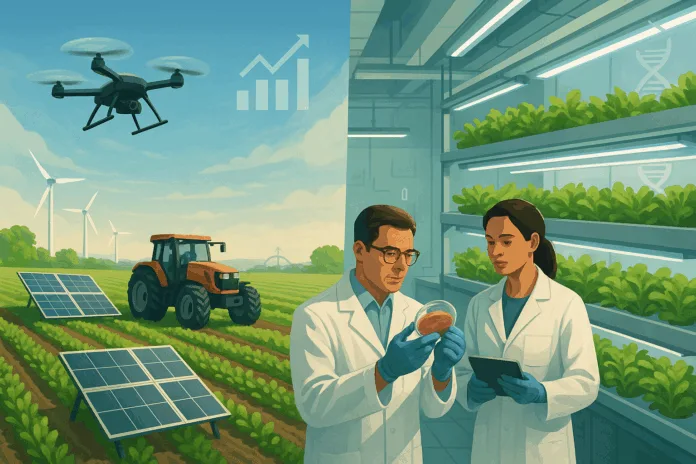
As the global population edges toward 10 billion by 2050, the pressure on food systems is intensifying. Traditional agriculture and food production methods are being stretched beyond their limits, both environmentally and economically. To meet future demands, sustainable food technology is emerging as a vital solution to feed the world while preserving the planet.
Within the first decade of the 21st century, the convergence of food innovation, biotechnology, and artificial intelligence began transforming how we grow, process, and consume food. These advancements are not only addressing food security but also helping to combat climate change, reduce waste, and promote healthier diets.
The Challenge: Feeding a Growing Global Population
According to the United Nations, the world will need to produce 70% more food by 2050 to meet the nutritional demands of the growing population. However, this growth must come without expanding agricultural land, overusing water resources, or increasing greenhouse gas emissions. The solution lies in technology-driven transformations across the food value chain.
Smart Agriculture: Farming Meets AI and IoT
Modern farming is no longer about intuition alone; it’s about data. Smart agriculture—powered by AI, the Internet of Things (IoT), drones, and machine learning—is reshaping how farmers monitor crops, use resources, and make decisions.
Precision farming enables farmers to use satellite imaging and sensors to assess soil health, moisture levels, and plant nutrition, leading to increased yields and reduced waste.
AI algorithms predict weather patterns, detect plant diseases early, and guide the optimal time for planting or harvesting.
Autonomous tractors and drones handle tasks like sowing seeds, spraying fertilisers, and monitoring crop growth without human intervention.
This form of intelligent agriculture reduces environmental impact and maximises efficiency, making it a core part of sustainable food technology.
Alternative Proteins: Redefining the Protein Supply Chain
One of the most innovative and promising areas in the future of farming is the development of alternative proteins. Traditional livestock farming is resource-intensive and contributes significantly to global greenhouse gas emissions. Enter protein alternatives—from plant-based meats to lab-grown cells and insect proteins.
Plant-based proteins, like those derived from soy, peas, and lentils, have gained popularity due to their sustainability and lower ecological footprint.
Cultured meat or lab-grown meat is produced by cultivating animal cells in a controlled environment, offering the taste and texture of real meat without slaughtering animals.
Insect protein is another emerging solution. High in nutrients and requiring minimal resources, insects like crickets and mealworms are being processed into protein powders and bars.
These breakthroughs in food innovation are not only environmentally friendly but also scalable for mass production, addressing both sustainability and global hunger.
Climate-Resilient Crops: Engineering for the Future
With climate change leading to unpredictable weather patterns, rising temperatures, and increasing soil salinity, traditional crops are under threat. Genetic engineering and biotechnology are being used to create climate-resilient crops that can withstand these environmental stresses.
Drought-resistant rice, salt-tolerant wheat, and pest-resistant maize are examples of how biotechnology is enhancing food security.
These crops require fewer chemical inputs, grow faster, and produce higher yields in marginal conditions.
Biotech-driven agriculture is becoming a linchpin in future food strategies, ensuring that global food supplies remain stable even under adverse climate scenarios.
Vertical Farming and Urban Agriculture
As urbanisation increases and arable land decreases, vertical farming is providing a compelling alternative. This technique involves growing crops in vertically stacked layers under controlled indoor environments, using hydroponics or aeroponics.
Vertical farms can produce crops year-round, consume up to 90% less water, and significantly reduce transportation costs by being located in or near cities.
LED lighting systems mimic natural sunlight, and climate controls ensure optimal growing conditions.
This innovation supports sustainable food technology by reducing the carbon footprint associated with traditional agriculture and improving access to fresh produce in urban areas.
Reducing Food Waste Through Technology
Another pillar of sustainable food systems is waste reduction. Approximately one-third of all food produced globally is wasted. Technologies such as AI-powered inventory management, smart packaging, and blockchain-based traceability are helping to minimise waste across the supply chain.
AI helps retailers predict demand more accurately to avoid overstocking.
Smart packaging extends shelf life and alerts consumers when food is nearing expiration.
Blockchain provides transparency from farm to table, ensuring food safety and reducing spoilage.
By reducing food loss, these technologies contribute to both economic savings and environmental conservation.
The Road Ahead: Challenges and Opportunities
While the promise of sustainable food technology is immense, challenges remain:
High implementation costs for new technologies can be a barrier, especially in developing countries.
Public perception and regulatory approvals for lab-grown meat and genetically modified crops need careful management.
Data privacy and digital literacy are essential when adopting AI and IoT-based agricultural solutions.
Despite these hurdles, the momentum behind food innovation continues to grow. Governments, startups, and global organisations are investing heavily in research and infrastructure to scale these technologies.
Conclusion
The future of food is being shaped by a fusion of innovation, sustainability, and necessity. Sustainable food technology is at the heart of this transformation—powering smarter farming, enabling alternative protein sources, and ensuring food security for generations to come. As we move forward, integrating these technologies into global food systems will be critical for creating a more resilient, equitable, and nutritious world.